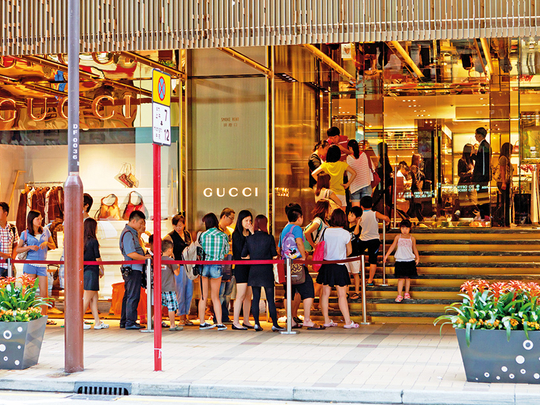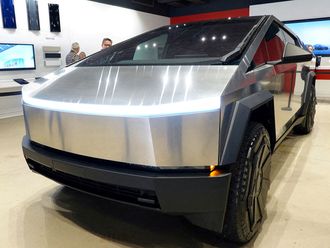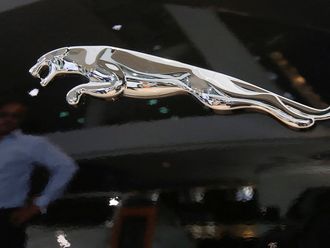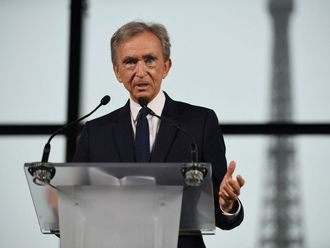
On London’s Bond Street, home to some of the most expensive retail space in the world, only one store needs to instigate crowd control, the luxury brand of the moment: the Italian fashion and accessories powerhouse Gucci.
By mid-morning on a wet and windy British midsummer day, burly security guards had erected velvet ropes along one side of the store’s gilded floor-to-ceiling windows. Inside, a dozen black-clad assistants raced around on magenta carpets, serving the 20-some customers on the ground floor. An orderly line made up mostly of tourists formed outside, many of them looking hungrily through the corner store’s glass panes.
It is this sort of slavish devotion from Gucci’s customer base that resulted in the brand’s reporting a 43.4 per cent increase in sales in the first six months of the year. That, combined with a sales increase of 28.5 per cent from its sister brand YSL, propelled its parent group, Kering, to record growth in revenue and profits for the period.
The Kering results came 24 hours after LVMH Moët Hennessy Louis Vuitton, the world’s largest luxury group by revenue, said strong growth in Europe and Asia had bolstered sales by 12 per cent in its second quarter. Profit for the first-half of the year also grew at its fastest rate since 2011.
Another rival, the upmarket Italian outerwear company Moncler, said it expected its business to grow further this year after it posted higher-than-expected growth in revenue for the first-half of 2017. That is part of a trend in the luxury sector. European power players do not just appear to be quietly on the rebound; they are back with an emphatic bang.
The success is evident on Bond Street, where Wendi Liu, a visitor from China, joined the line outside the Gucci store, accompanied by her older sister. Clutching their iPhones, the pair wore oversized Gucci sunglasses and planned to shop for sneakers, loafers and possibly handbags once inside the boutique.
“I am completely obsessed,” Liu said. The siblings expressed a deep admiration for Gucci’s Renaissance Man, its bearded and charismatic creative director, Alessandro Michele. In just over two years, and with the help of Gucci’s chief executive, Marco Bizzarri, Michele has spearheaded a striking turnaround in fortunes for the once-beleaguered fashion house, forged around his colourful and maximalist aesthetic, slick leather goods collections and savvy use of social media.
“I love the clothes and the advertising campaigns, but the bags are really why I am here,” said Julieta Vega, a tourist from Spain on a weekend trip. She already had three Gucci handbags, and added that every time she went abroad she visited the local Gucci store. “You never know what they might have there that you can’t get anywhere else,” Vega said.
Customers like Liu and Vega are propelling a resurgence for Gucci and its parent company. Kering, which also owns brands like Balenciaga and Alexander McQueen, said that total like-for-like sales grew 26.5 per cent year-on-year in the first six months of 2017 to 7.3 billion euros ($8.5 billion), while recurring operating income increased 57.1 per cent to nearly 1.3 billion euros, both of which outperformed analysts’ estimates.
The results paint a markedly more positive picture than previous years for European luxury companies. Last year, the global market for personal luxury goods failed to grow for the first time since the financial crisis, stalling at 249 billion euros, according to the consulting firm Bain & Co. The sector had been hit by an economic slowdown in China, currency volatility harming the bottom-line, and customer sentiment that was damped by violence and terrorist attacks.
That is now changing, and the performance of European marques this year has been bolstered by a resurgence in Chinese consumer spending, both at home and abroad, a recovery in Europe’s tourism sector, and efforts by luxury brands to identify and respond to the tastes of specific groups of consumers, particularly millennials.
Louis Vuitton, for example, unveiled a wildly popular collaboration with the cult streetwear label Supreme, via limited-edition drops in pop-up stores around the world, a sales strategy embraced by under-25s. Gucci, which has a strong and varied digital base, was one of the first brands to display its shows on Snapchat and has said that millennials make up almost half its consumer base.
“The market is facing a “newness imperative” as many luxury consumers — especially Chinese shoppers who buy more and more frequently — already own enough of the core pieces and staples,” said Luca Solca, who heads luxury research at Exane BNP Paribas. “Hence they will only part with their money if brands bring them something really new and exciting. Those on top are the brands who have recognised that.”
The success of European luxury giants stands in contrast to their rivals across the Atlantic. Having failed to maintain an adequate balance between ubiquity and exclusivity — a formula that has come to dictate the success or failure of a modern luxury brand — the likes of Ralph Lauren, Michael Kors and Coach are now grappling with the effects of overexposure and a devaluation of their brand in the eyes of shoppers.
An overexpanded store network, excessive discounting and an overreliance on outlet sales have hit their results hard. To make matters worse, traffic to shopping malls and department stores in North America has been in a long-running decline, and online competitors, most notably Amazon, are making headway. Unlike LVMH and Kering, companies that eschewed discounting to maintain pricing power and market position, affordable-luxury kingpins in the US chased meteoric growth targets, which have come crashing down.
Several are now locked in an arms race to buy up new brands both to increase growth and to diversify. In May, Coach bought the handbag brand Kate Spade for $2.4 billion, and Michael Kors looked upmarket — and to Europe — for its first major acquisition, buying the luxury London-based shoemaker Jimmy Choo for $1.2 billion.
With shoppers appearing to gravitate to extreme ends of the spectrum — toward either fast-fashion giants like Zara and H&M, or top-tier houses like Gucci and Fendi — those that occupied the “middle market” have been left painfully exposed.
Despite their glowing reported results, however, even the European power players voiced caution. Bernard Arnault, the chairman and chief executive of LVMH, warned that its results had been helped by the favourable comparison against results from a year ago, when sales were hit by a fall in tourists to Paris after terrorist attacks in France.
Kering warned that a stronger euro could hurt sales and curb tourism, resulting in more moderate growth in the future. Still, its Gucci brand accounts for around half of Kering’s total sales. And this week, at the Gucci Bond Street store, customer appetite showed no sign of slowing. Though the line outside the shop had been short in the morning, come lunchtime it was snaking around the block.
New York Times News Service












